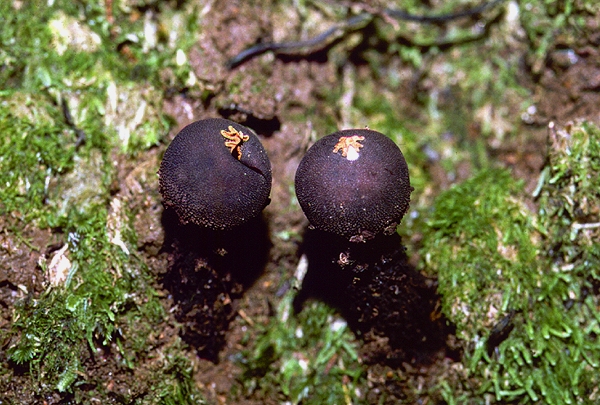
Calostoma fuscum (Berk.) Massee

Common name: None.
Description: The entire fungus takes the form of a small ball-shaped sack (a peridium) on a curiously twisted gelatinous stem. The peridium is about 12 cm in diameter, rather rough, and is often apparently black; however some variants are deep sooty brown. The upper half of the peridium is at first enclosed in a convex cover (the exoperidium) which eventually splits away. The cover is smooth on the inside but marked right at the inner top by a reddish star. This star centres on the opening (stoma) of the middle layer of the peridium (the mesoperidium) through which the spores escape. The stem is commonly about 24 cm in length and up to 1 cm thick. It is dark brown to black and is composed of numbers of twisted, braided, gelatinous threads each of which is about 23 mm in diameter.
The spores measure 1014 × 810 µm and are broadly ellipsoidal, pitted and colourless or faintly brownish tinted. The ejected spore mass is white to cream-coloured.
Substratum: This species can be found on mossy soil in damp places. Sheltered banks beside pathways are very suitable sites and it has been found in both eucalypt forest and rainforest.
Distribution: Known from Queensland, New South Wales, Victoria, South Australia, Western Australia and Tasmania.
Notes: The discarded covers of this puffball can often be found beside the mature fruiting bodies and the colour of the bright red decorations on the top of such a dark-coloured fungus often excites comment. The species appears to be widespread and common. However, it is easily overlooked, especially when the bright red star-shaped structure has faded. Sometimes old specimens may be found with a white, papery membrane partially ejected out of the stoma. This is an internal sack (the endoperidium) which contains the spores and which is occasionally ejected if the raindrops falling on the outer membrane have been particularly violent.
